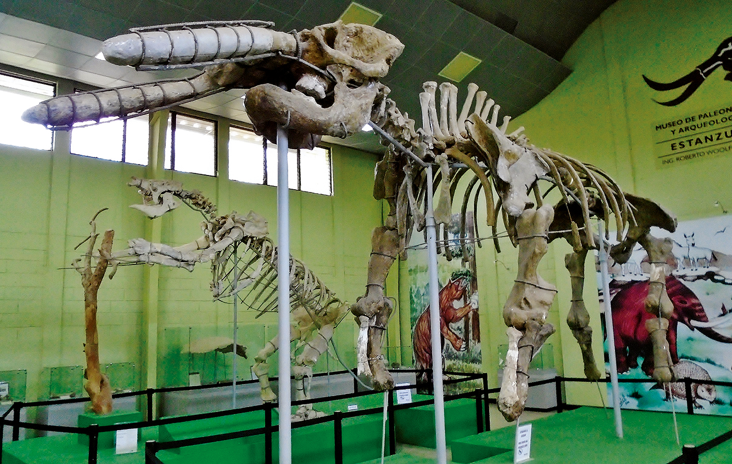Abstract
The fossil vertebrates of Guatemala are almost exclusively fossils of mammals and are of late Miocene (Hemphillian) and late Pleistocene (Rancholabrean) age. The only lower vertebrates are the crocodile fossil Crocodilus moreletti collected in the Río La Pasión area, a turtle from El Trifinio and fishes from Río Carboneras. The late Miocene mammals are the proboscidean Gomphotherium, an aceratheriine rhinoceros and the horse Neohipparion from the Río Carboneras in Izabal; the holotype of “Serridentinus guatemalensis” (nomen dubium) from Chinautla in the Department of Guatemala is also a specimen of Gomphotherium of likely late Miocene age. Late Pleistocene vertebrates are known from at least 36 localities in Guatemala, but only six of these yield at least four documented genera of mammals—Chivacabé, Ciudad Real. El Rosario, Estanzuela, Río La Pasión and San Rafaelito. The combined list of Guatemalan late Pleistocene mammal genera is Canis, Cuvieronius, Dicotyles, Equus, Eremotherium, Euceratherium, Glyptotherium, Holmesina, Mammuthus, Mazama, Megalonyx, Mixotoxodon, Neochoerus, Odocoileus, Pachyarmatherium, Palaeolama, Paramylodon, and Tapirus. The late Pleistocene mammals from Guatemala resemble broadly correlative mammal assemblages from throughout Central America in being dominated by the fragmentary remains of large herbivorous mammals and in having a mixture of immigrants from both North and South America. They thus well reflect a substantial taphonomic megabias in the Central American Pleistocene mammal record towards large mammals with large and durable skeletal parts that are easily preserved and readily discovered. This megabias renders problematic direct biological inferences from the Guatemalan Pleistocene mammal record. Mammoth records from Guatemala are relatively numerous for a Central American country but so few that inferring extensive grasslands or positing migration routs of mammoths from these records are questionable. There is no demonstrable association of humans with extinct Pleistocene megamammals in Guatemala despite claims to the contrary. The suggestion that during the late Pleistocene Guatemala was north of a biogeographic juncture between North and South America lacks any support. The Guatemalan fossil vertebrate record needs extensive augmentation, with an appropriate stratigraphic context, especially of lower vertebrates and micromammals, to provide further insight into vertebrate history in Central America during the last 10 million years.
Comments

This work is licensed under a Creative Commons Attribution-NonCommercial-ShareAlike 3.0 Unported License.
Copyright (c) 2023 Spencer G. Lucas, Jorge E. Romero, Osmín J. Vásquez, Guillermo E. Alvarado






